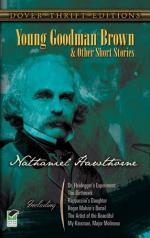|
This section contains 8,763 words (approx. 30 pages at 300 words per page) |

|
SOURCE: “Hawthorne's ‘Young Goodman Brown’: Early Nineteenth-Century and Puritan Constructions of Gender,” in New England Quarterly, Vol. 69, No. 1, March, 1996, pp. 33-55.
In the following essay, Keil focuses on the blurring of masculine and feminine spheres in “Young Goodman Brown” and suggests that the reader needs to take into account historical as well as psychological implications of gender in the tale.
Nathaniel Hawthorne's “Young Goodman Brown” traditionally has been read as an examination of crises of faith, morality, and/or psychosexuality. Early readings focused on questions of theology and conduct,1 but since the opening years of the 1950s, a second category of readings has emphasized the psychosexual elements. Roy Male, for example, argued that “the dark night in the forest is essentially a sexual experience, though it is also much more,” while Frederick Crews observed that in his dream experience, the young, newly wed, and still oedipal Brown, fleeing...
|
This section contains 8,763 words (approx. 30 pages at 300 words per page) |

|


